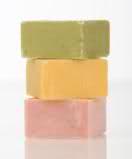 Biodegradable detergent soap uses all-natural products that are mild to the skin and clothes and, in addition, are eco-friendly. In contrast, commercial detergent powder contains chemicals such as optical brighteners, dyes, and artificial fragrances that can sometimes irritate the skin.
Biodegradable detergent soap uses all-natural products that are mild to the skin and clothes and, in addition, are eco-friendly. In contrast, commercial detergent powder contains chemicals such as optical brighteners, dyes, and artificial fragrances that can sometimes irritate the skin.
With a capital of as little as P700, you can start your own biodegradable detergent powder business to meet this market demand. You only need to purchase the following materials:
• 1 kilo (kg) sodium sulfate
• 500 grams (g) (coconut-based)
• 200 g coconut powder
• 6 ml bilimbi fruit (kamias) extact
• 10 g blue speckles
• 120 ml fragrance (kalamansi scent)
• 5g sodiumtripolyphospate (STPP)
Most of the materials for the detergent-making powder are available locally.
Most of the materials needed to make biodegradable detergent powder are imported from Malaysia, China, and India. However, you can also buy them locally from soap-suppliers stores in Divisoria, Manila. Magic Ultra is available from ESF Cakes and Bread House.
You can produce the kamias extract by fermenting 1 kilo of the bilimbi fruit in a jar with 2 tablespoons of salt. After 24 hours, get the extract, strain it, then transfer it to another container. It will be then ready for use.
What each ingredient does
1. The base material of Magic Ultra being coconut, it serves as the foaming ingredient of the detergent.
2. Blue speckles serve as the bleaching agent. It has whitening components such as the sodium sulfate and sodium berborate.
3. The kamias extract serves as a stain remover and also helps whiten your clothes.
4. The kalamansi scent is needed to give the detergent a natural scent.
Procedure:
To start making the detergent powder, prepare a mixing bowl and measure all the materials. Mix the sodium sulfate, the Magic Ultra, and the coconut powder in the bowl until it becomes powdery. Once powdery, add to the mix the STPP along with the kamias extract and the kalamansi fragrance. Mix carefully, then add the blue speckles. Once the materials are mixed well, pack the mixture and label the powder. You may pack them in 250g-, 500g-, or 1kg- packs. You can also put a powder scoop inside the pack as a value-added item. The total yield of this project is 1,750 g or 1.75 kg.
Costing and pricing
To determine the selling price of your biodegradable detergent powder, compute first your total production cost by getting the cost of the materials you used for this project. Add to the total cost a certain percentage for your desired markup. Divide the sum with the total yield to get your selling price per pack. If you are going to the product at home and in limited amounts, it is recommended that you add a 100 percent markup to the total production cost. If you plan to mass-produce the detergent, however, you may separately add a percentage for your overhead costs plus your profit margin.
Do’s and Don’ts
1. Never use glass bottles to ferment kamias extract. The acid of kamias may cause the bottle to explode when opened =. The use of plastic containers is recommended.
2. Use dark-colored reagent bottles in order to dissipate the perfume (fragrance). To avoid contamination, do not use plastic bottles.
3. Use gloves for protection while making the detergent powder.
4. Keep everything away from children’s reach.
5. Be sure to measure all the ingredients accurately.
6. Seal your finished product well.
Coffee Scented Soap
This particular recipe is for coffee scented soap, which is suitable for vegetarians and vegans because it uses all vegetable oils rather than tallow. This is just one of the scents (or scent combinations) you can choose; feel free to experiment with different fragrances! However, before creating your own mixtures, be sure to calculate the exact concentrations of ingredients needed. Too much lye can make your soap overly abrasive, while too little lye can make your soap very oily.
Ingredients:
• 8 ounces (227 grams) soybean oil
• 4 ounces (113 grams) coconut oil
• 4 ounces (113 grams) olive oil
• 5 ounces (142 grams) coffee (to be used instead of water)
• 2 ounces (57 grams) lye
Most of the above vegetable oils can be found in regular grocery stores, and there are a variety of websites that sell lye online.
Additional Materials Needed:
• Safety goggles or glasses
• Safety gloves
• Small scale
• 2 large measuring cups
• Wooden spoon or hand mixer
• Pan
• Thermometer
• Knife
• Plastic container to use as a mold
• Wax paper
Note: Because lye fumes are hazardous, be sure to work with lye in a well-ventilated area.
Instructions:
1. Make a cup of coffee and put it into the refrigerator, making sure it cools thoroughly.
2. Pour the appropriate amount of cold coffee into a measuring cup.
3. Put on the safety goggles and safety gloves.
4. Put the measuring cup on the scale and set the scale to zero. This ensures that the scale is only measuring the amount of lye and not the weight of the measuring cup.
5. Pour the lye into the measuring cup until the scale reads the correct amount. Be extremely careful with the lye! Do not breathe in the fumes.
6. Without letting anything splash, slowly pour the lye into the coffee in the other measuring cup. Absolutely do not pour the coffee into the lye!
7. The lye-coffee mixture will be hot, so set it aside temporarily to cool. Check the temperature occasionally with a thermometer, making sure it does not go below 100º F to 110º F.
8. Stir the soybean oil, coconut oil, and olive oil in a pan. Heat the pan on the stove until the oil mixture temperature on the thermometer reads 100º F to 110º F.
9. When the lye mixture and oil mixture reach the exact same temperature, stop heating the pan.
10. Slowly pour the lye mixture into the oil mixture.
11. Making sure not to let anything splash, stir the solution vigorously.
12. Keep stirring steadily and carefully until the mixture has the texture of honey. If you are using a wooden spoon, this part can take up to an hour. If you use the hand mixer, it can take a matter of minutes. However, be especially careful not to splash the mixture or speed up the process too quickly.
13. Pour the solution into the plastic container mold and put the lid on. Wrap the mold in a blanket or towel to insulate the soap in order to keep it warm. Leave it like this for 48 hours.
14. Unwrap the blanket or towel and take the lid off of the plastic mold. If the solution is still soft, leave the mold with top off for another day. If it has hardened, peel the soap away from the sides and turn the mold over onto wax paper.
15. Run the knife under hot water to heat it, and then dry it with a clean towel.
16. Cut the soap into bars.
17. Leave the soap bars out in the open for 3-4 weeks to let them cure. Although you can start using them after a day or so, curing them allows them to last longer and lather better.
Marketing Strategy
Along with word-of-mouth from satisfied users, giving out trial packs is still the best marketing strategy for this small-scale business. It is therefore advisable to give sample of trial packs to your friends and relatives so they can assess and evaluate your product before you start selling them.
Sources: Mishell Malabaguio www.entrepreneur.com.ph, www.greeniacs.com
Photo: motherearthnews.com
Do you like this Money making business ideas? then please consider subscribing to our RSS feed and have new business ideas sent directly to your inbox. (Once you entered your e-mail address, you need to login to your e-mail account and click the link to confirm your subscription).




Please give me more details about magic ultra and also advise whether STPP shall be replaced with natural item or not.
Beauty bar soap
is the coffee scented soap a body soap or a detergent soap?